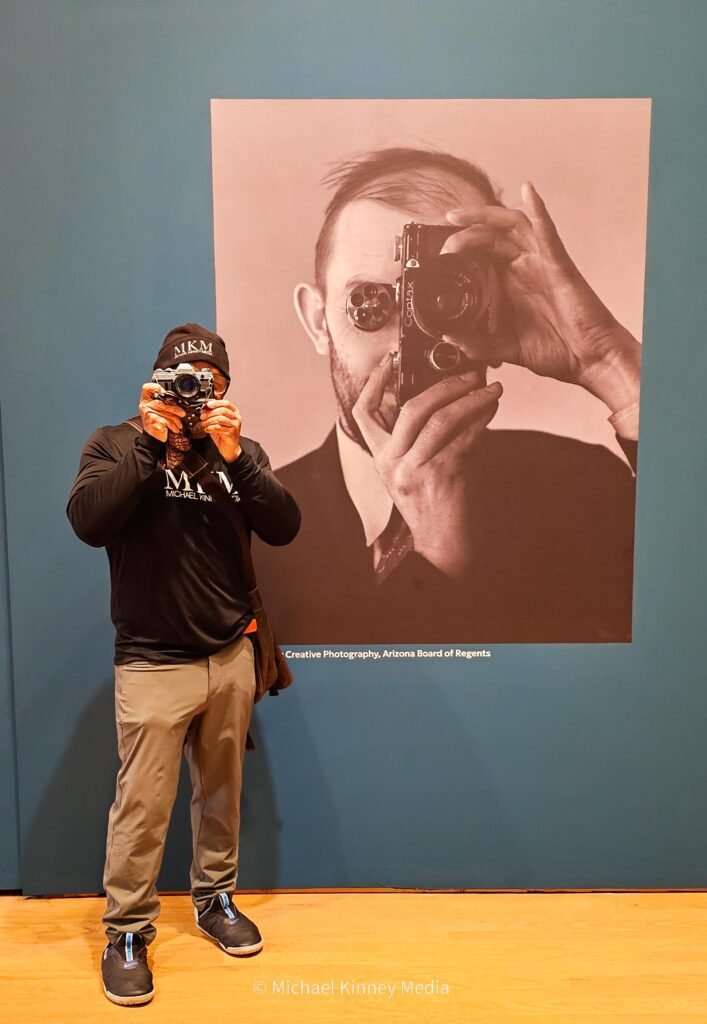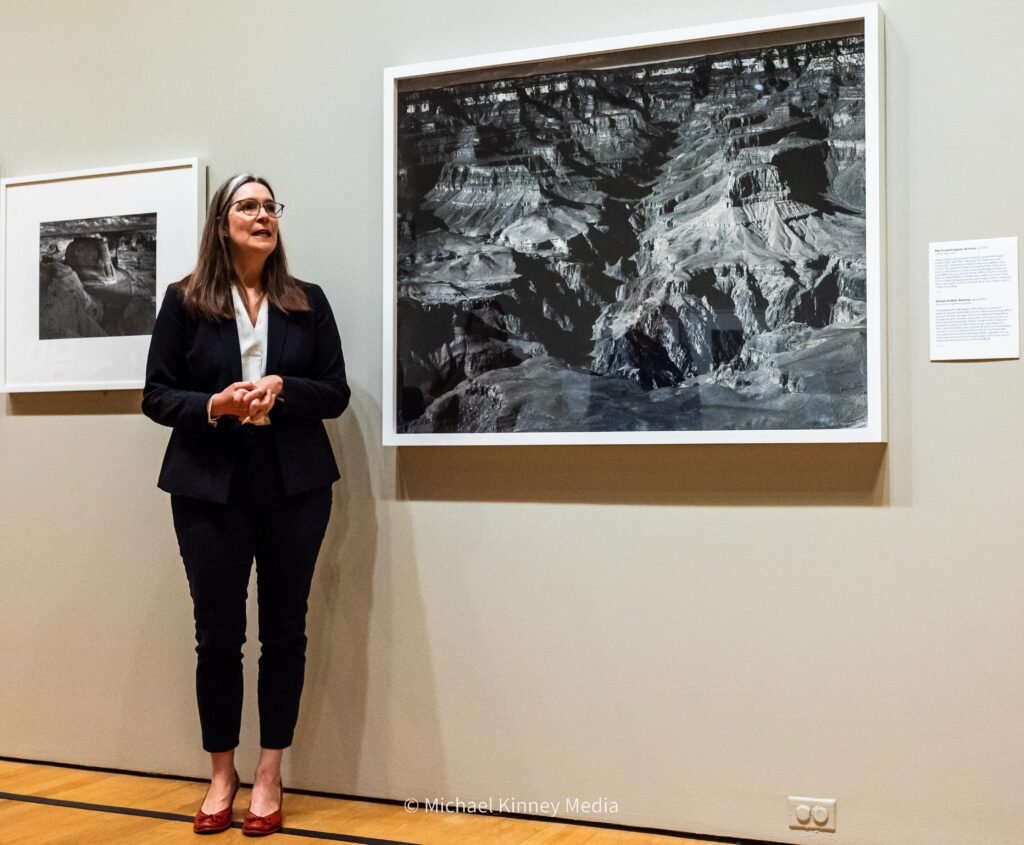Story & Photos
By Michael Kinney
The first image you see when walking through the gallery door of the Discovering Ansel Adams exhibit is Ansel Adams himself. However, the large, black and white image has nothing to do with the panoramic nature scenes he became famous for producing.
No, the image is just of Adams holding a Contax camera to his face that was taken in 1936. There are no enormous mountains, trees that reach to the sky or cascading sunsets over deep valley gorges. Just a photographer fascinated by a new camera.

At the end of the day, that is what Adams was at his core. A photographer who just happened to create some of the most awe-inspiring landscape photographs the world had ever seen up to that point.
As I have delved deeper into my own world of taking and selling fine art photography prints, it’s hard not to marvel at the industry Adams almost created single-handedly.
If at any time you have seen a miraculous-looking landscape print on a museum wall or gallery, there is a good chance it was Adams or inspired by him. That is the type of impact he has had not just on the world of art, but also on the business side.
Born in 1902, Adams became one of the most famous photographers of the 20th century. Along with Henri Cartier-Bresson (who often criticized Adams), Dorothea Lange, Robert Capa, Andreas Gursky and Gordon Parks, they helped turn photography from just a pastime into an art form.
While it’s debatable who was the better photographer, there is no argument about who is the most well-known. That is Adams by a country mile.
Some of Adams’ most famous fine art photography prints have garnered impressive auction prices. Moonrise sold for $381,000 in 2023. Clearing Winter Storm earned $722,500 in 2010, while Tetons and Snake River realized $988,000 in 2020
While I never had much interest in landscape photography growing up, it has taken up a large part of my portfolio and galleries in the past year. Whether I am in Oklahoma or overseas, I find myself checking out scenarios just as much as people.
So when the Oklahoma City Museum of Art announced earlier in the summer that it would be hosting Discovering Ansel Adams, I knew I couldn’t miss it. The exhibit features more than 100 photographs of his most “celebrated works while revealing aspects of his development that are frequently overlooked.”
Rebecca Senf, who is the Chief Curator at the Center for Creative Photography and the guest curator for Discovering Ansel Adams, put together the exhibition with the intent of showing spectators all sides of Adams.
“He was a teacher. He was a leader. He helped create, literally helped create a market for the sale of fine art photographs that didn’t exist, so art photographers now are benefiting from the work that he did to help create collectors and to encourage galleries to sell artworks,” Senf said. “He was just so committed to the potential of photography as an expressive art form that he hammered away at it, and that really ended up changing the world.”
I sat down with Senf for a Q&A to get a better understanding of Adams as an entrepreneur, his mindset on photography, and his impact on the art world.
Question: First, what made Ansel Adams special?
Senf: I think people who know about Ansel Adams may be familiar with some of his photographs of the wilderness. They have a kind of awesome quality. They’re very inspiring. They might make you think about the beauty of nature or the potential experience in nature. But this exhibition introduces you to Ansel Adams, the person, and helps you understand why did he make pictures like that, and what was his journey from the beginning of his career to becoming the famous photographer that we know.
Question: Many of his images that are on display were taken more than half a century ago. Why are they still important?
Senf: I think that the pictures are interesting to see, important to see in this moment, because nature continues to provide solace to people, and it can be something that it helps improve our mood, or it makes us feel healthier, or it allows us to connect with something larger than ourselves, and that was what Ansel Adams’s intent. He really valued experiences in nature, and he was trying to share that with people through his photographic works.
Question: Adams often put more time into the actual making and editing of the print than the time it took him to get the photo. Why was that important to him?

Senf: He was really interested in the craft of the photographic print. He was not just trying to convey the image across to an audience, but he was trying to make an object that was beautiful, that was detailed, that was an experience in and of itself, and so that changed over the course of his lifetime. He settled into working with a particular kind of gelatin silver paper, which is a black and white paper, and making bigger prints that had more power and more emotional draw for the viewer.
Question: If there was one thing about his life or his career that you think more people should know about, what would it be?
Senf: I think that it’s exciting to understand Ansel Adams as a mountaineer. That as a young man, he was exposed to hiking and camping and being out in the wilderness, and as a teenager, he fell in love with it. He had so much passion about the value of being in the wilderness. It was where he learned how to navigate, and he learned about birds and identifying trees and the constellations and the geology, and that changed him. It made him connected to and committed to the wilderness, and that’s what informed the photography he made throughout his whole career.
Question: For those who take in the Discover Ansel Adams exhibit, what do you want them to take away from it?
Senf: I hope that people are inspired by the exhibition to think about their own relationship to the natural world and how they find connections to the beauty, to the peacefulness, to the inspiration that we can find in the landscape. Adams spent his career invested in that. I hope that it inspires people to think about their own relationships to the natural world.”
Discovering Ansel Adams will be on display at the Oklahoma City Museum of Art until Sept. 28. From there, it will head to the Baker Museum in Naples, Fl. in 2026.
Instagram: mkinneymedia
X (Twitter): MKinneyMedia
Youtube: Michael Kinney Media
Photos/Prints (SmugMug): Michael Kinney
MKM Apparel: Michael Kinney Media

